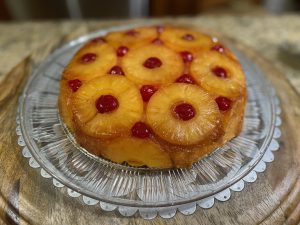
WOW! Your Guests with Holiday Baking
Holidays are truly worth celebrating! And baked goodies are but just one way many families observe not just the holiday but family traditions and what is special.

Photo source: Heidi Copeland, UF/IFAS Extension Leon County
Nonetheless, baking brings on an anxiety that cooking does not. In fact, baking is considered a science by some, whereas cooking is an art. Baking requires fairly exact measurements, whereas cooking can be very forgiving. Adding or subtracting ingredients can be personal discretion. For the most part, you cannot do that with a baked product.
However, once you get the basics down, the world is your oyster… you can do anything you want.
In baking, every ingredient has a specific purpose. For example:
- Flour gives the structure to baked products (there are many types of flour)
- Eggs bind the ingredients and can add to the leavening (think fluffy egg whites) to baked goods
- Baking powder, baking soda, and yeast are leaveners (make baked products rise)
- Fats, like butter, margarine, oils, or lard, add both flavor and texture to baked products
- Flavorings (like vanilla) enhance the flavor of a recipe… know that a little goes a long way
- Sugar sweetens and adds to the texture of baked products (there are many types of sugar)
- Salt enhances the flavor of all the other ingredients in a baked product
Know, too, that in baking, measuring is of utmost importance. Dry ingredients should be measured in a dry measuring cup and wet ingredients in a liquid measuring cup. Small amounts of both wet or dry ingredients can be measured with measuring spoons.
Using a kitchen scale is the most accurate way to measure both liquid and dry ingredients. Accuracy in baking is of utmost importance. That is what science is all about. Too much or too little of an ingredient can mean disaster.
Other helpful baking tips include understanding the processes. Terms in baking include (but are not limited to):
- Beat
- Blend
- Cream
- Cut in
- Fold in
- Grease and flour
- Mix
- Whip
And then there are other issues. Baking requires an oven that has temperature controls. Knowing how your oven works is quite important. It never hurts to purchase an oven thermometer to check temperature accuracy. Know the property of the pans you are using. Baking pans can be made from a variety of materials… aluminum, cast iron, ceramic, glass, stainless steel, etc. Each of these heats a bit differently.
Holiday baking recipes can be heavy on fat, sugar, and sodium. Baking holiday goodies can be done nutritiously. The secret is to bake with simple substitutions. It is possible to use healthier ingredients without sacrificing flavor.
Here are some ways to lighten up your holiday baking:
Ingredients Substitute
- 1/2 cup butter/margarine 1/4 cup applesauce & 1/4 cup canola oil
- Sweetened Condensed Milk Low-fat sweetened condensed milk, low-fat evaporated milk
- Egg (1) 2 egg whites or 1/4 cup egg substitute
- Evaporated milk Evaporated skim milk
- All purpose flour (1 cup) Whole wheat flour, cake flour, or self-rising flour
- Salt Ground spices
- Heavy cream (1 cup) 1 cup evaporated skim milk
- Margarine (stick) 1/4 cup olive or canola oil
- Sugar (1 cup granulated) Brown sugar or marketed sugar substitute
- Buttermilk (1 cup) Milk and vinegar, milk and lemon juice, or sour cream and milk
- Chocolate chips (1 cup) 1/2 cup mint chocolate chips, dried fruit, chopped nuts
Chart adapted from American Cancer Society
The Home Baking Association, https://www.homebaking.org/, is a great website to reference. Their main goal is to perpetuate generations of home bakers.
Don’t be intimidated by baking. With a bit of patience and practice, you will be able to WOW! your holiday guests with delectable treats that may become a family holiday tradition for generations to come.
Heidi Copeland, CFCS
Extension Agent
Leon County Extension
Dorothy C. Lee, CFCS
Extension Agent
Escambia County Extension

